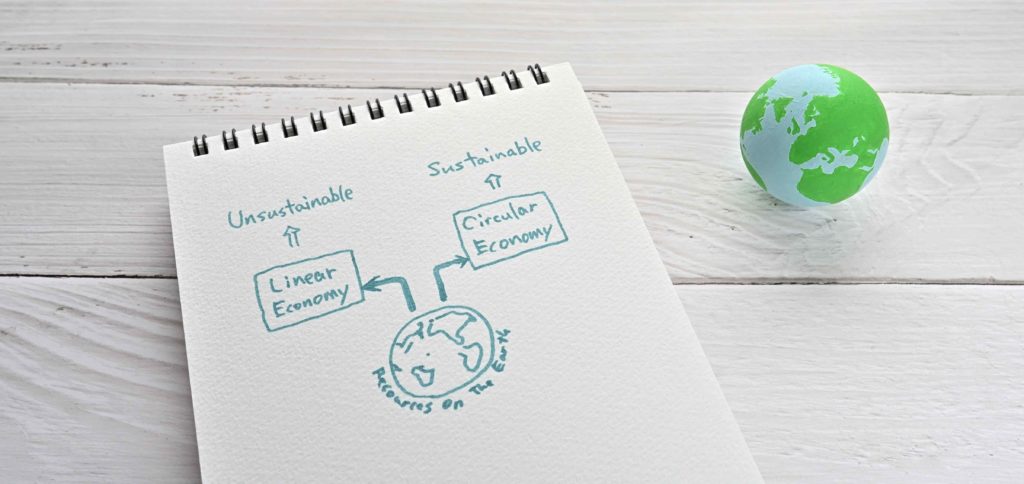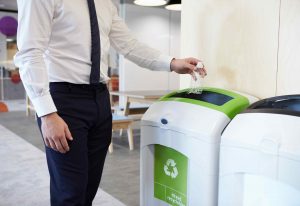Sustainable waste management aims to keep materials in use for as long as possible and minimize the amount of solid waste that is disposed of in landfill or through incineration. However, in our existing linear economy, waste begins even before products are manufactured, and a more in-depth approach to sustainable waste management must focus on the entire lifecycle of a product to enable us to help reduce the negative environmental, social, and financial impacts of 21st-century consumption.
The question then, of what exactly is sustainable waste management, is important if we are to refine and improve our existing waste management systems. Whether focusing on waste reduction at end-of-life or designing waste out of the production cycle at the conceptual stage, new waste management practices are required to effectively deal with existing waste streams while also reducing the amount of waste at the same time.
What makes sustainable waste management so important?
Sustainable waste management is a central part of a broader circular economy. It’s a systemic approach to economic development that stands in opposition to the take-make-waste model and aims to separate growth from the consumption of finite resources. Sustainable waste management helps tackle the broader issues of a linear consumption society, but also offers more direct solutions to the many problems waste causes.
Failing to follow the sustainable waste management hierarchy means that otherwise usable goods and materials are sent to landfill or incinerators as part of energy recovery programs.
Paper and paperboard
According to the EPA, the single largest component of municipal solid waste (MSW) in the United States is paper and paperboard products, which while usually biodegradable and less damaging than plastics, still place undue stress on our environment through wasteful consumption.
The use of raw materials within the manufacturing of new products in paper and card causes deforestation, as well as using massive amounts of energy and water. Additionally, while this particular waste stream has very high recycling rates, 100 million tons of wood could be saved each year if all wasted paper was processed through effective recycling programs, with just one ton saving “17 trees, 2 barrels of oil (enough to run the average car for 1,260 miles), 4,100 kilowatts of energy (enough power for the average home for 6 months), 3.2 cubic yards of landfill space, and 60 pounds of pollution.”
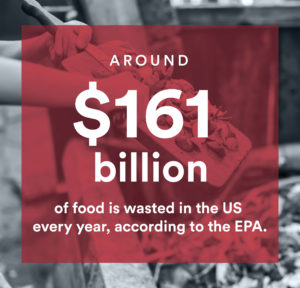 Food waste
Food waste
Food waste is the second single largest component of municipal solid waste, at 21.59% according to the EPA, and has major social, financial, and environmental impacts. In the US, the amount of food wasted amounts to roughly $161 billion a year, or nearly 40% of the total US food supply. To compound the issue, around 10% of all US households suffered some level of food insecurity in 2019, and much of the food that ends up wasted is perfectly edible. Sustainable waste management could actually keep “waste materials” in the loop through donation or composting, but instead our existing systems send it to landfill where it breaks down and releases CO2 and methane, both of which contribute heavily to global warming.
The issue of inefficient solid waste management begins with the impact of food production in the first place, which accounts for more than a quarter of global greenhouse emissions and more than 70% of freshwater withdrawals. Unless we can address overproduction at the source, it seems unlikely that collection systems will be able to deal with the sheer amount of waste produced on any given day.
Plastic
The third-largest component of MSW is plastics, which have become the poster child of the dangers of a linear economy, with single-use products choking land and ocean. From the petrochemicals that must be extracted to produce new material to the estimated $2.5 trillion in damage and lost resources, plastic waste is a problem. Sustainable waste management means reducing and avoiding the amount of single-use plastic products along with increasing the amount recycled at the same time, which currently stands at just 8.5%.
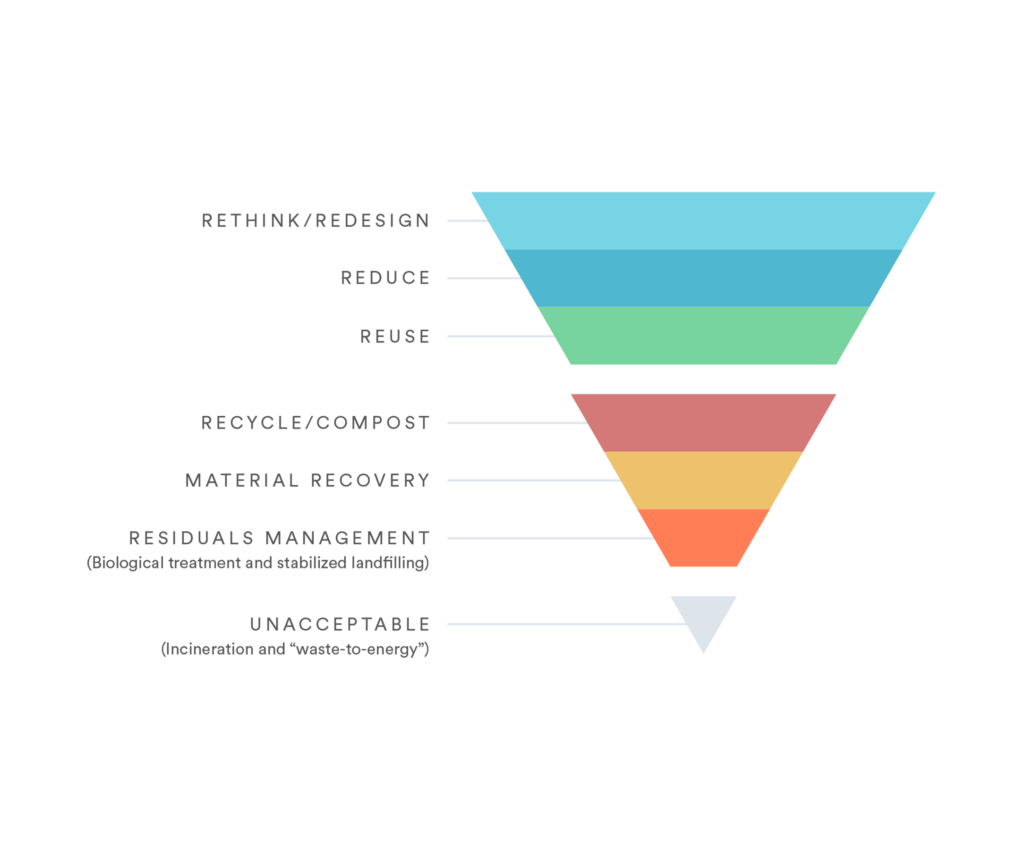 Placing waste on the hierarchy
Placing waste on the hierarchy
Sustainable waste management relies on the waste management hierarchy, a system that focuses on avoidance, reduction, reuse, recycling, energy recovery, and finally, treatment or disposal. It aims to prioritize actions for the most efficient use of resources, placing renewable and less wasteful practices at the top of the pyramid. Here, we look at how the waste management hierarchy is central to sustainable waste management.
Avoidance and reduction
Avoiding and reducing the amount of waste generated is the first priority. This can be achieved by maximizing efficiency and reducing consumption. First, businesses and individuals should choose products that require the fewest resources to produce (including the packaging). Additionally, single-use or disposable goods should be avoided wherever possible— these materials are the embodiment of linear waste in which resources are extracted, processed, and distributed only to quickly become waste.
Reuse and recycling
If the consumption of a product can’t be avoided, then there should be a focus on purchasing products that can be reused or repaired, as well as education around how to reuse waste products. Reusing is preferred to options lower down the hierarchy since it can be done without processing new materials, which takes money, energy, and often other resources. Reuse, which is also one of the central tenets of the zero-waste philosophy, can come in the form of having shoes repaired, donating clothes and items for others to use and even researching recipes for food leftovers rather than throwing them in the trash.
If an item can’t be reused, then the next best option is to recycle. This is where the process starts to look like conventional waste management since we are now dealing with materials that have reached the end of their usable life in their current form. Recycling, like reuse, keeps materials in the loop, avoiding the need to extract virgin resources as well as negating some of the negative impacts of simply disposing of waste.
Recycling is considered less desirable than the previous options since it requires energy, money, and resources to turn waste back into usable materials.
That said, the benefits associated with recycling varies dramatically from material to material, with the likes of aluminum more than covering the cost of its own recycling while saving more than 90% of the energy required as compared with using virgin metal. Glass, on the other hand, has energy savings of only 10 to 15%, still being a better alternative to simple waste disposal. Composting is also found at this step of the hierarchy since it allows organic waste to be diverted from landfill and turned into something that can be useful in growing new produce.
Energy recovery
The next step is energy recovery, which is the conversion of waste into usable heat, electricity, or fuel such as biogas. This is achieved through a variety of processes such as incineration (with energy collection), gasification, pyrolization, anaerobic digestion, and landfill gas (LFG) recovery, which has some crossover with the last step of waste management.
Combustion is a common method of energy recovery for non-hazardous waste, and while obviously less preferable than reuse or recycling, it does reduce the physical volume of waste that will be sent to landfills and also provides energy from the burning process that would otherwise require fossil fuels to generate. In the United States, there are currently 75 facilities that recover energy from the combustion of MSW, each of which generates around 550-kilowatt hours (kWh) of energy per ton of waste. Having said all this, energy recovery is not included on the list zero waste priorities, and is viewed by some in the waste management industry as an unacceptable compromise.
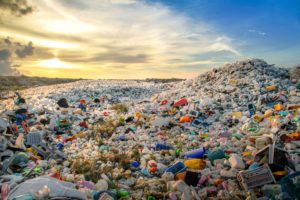 Treatment or disposal
Treatment or disposal
The last and least desirable step in the hierarchy is treatment or disposal. This generally means landfills or incineration without energy recovery. This will inevitably happen to some waste but should be avoided for as long as possible through sustainable waste management.
Ways to start making your waste management more sustainable
There are some simple ways to start implementing sustainable waste management in homes and businesses, and here a few tips to help you figure out how and where waste is being generated and take steps to tackle it.
 Scrap single-use items
Scrap single-use items
Replace single-use items with reusable ones. Instead of cardboard coffee cups, get mugs or glasses. It’s also important to note at this point that even at commercial composting plants, many seemingly green items — such as compostable coffee cups — can’t actually be composted, and instead break down in landfill. Switching to a greener alternative could save the planet as well as money.
 Switch to digital
Switch to digital
As mentioned earlier, paper and paper products make up the single largest part of MSW. For businesses, a relatively easy way to improve sustainable waste management is by switching as much paperwork as possible to digital versions. This could be issuing/receiving invoices online rather than physically, having meeting minutes in a shared document rather than printed, or switching to online banking.
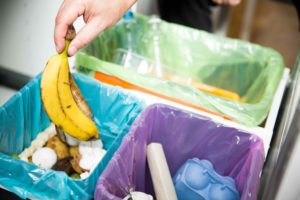 Offer a trash alternative
Offer a trash alternative
It is likely that many types of waste will be generated in a business, and one way to drive more sustainable waste management is providing the means for all employees to take action. This can be as simple as providing recycling and compost bins alongside regular trash and having services to properly manage this waste.
Can someone else use it?

Reuse is better than recycling, so considering whether a business can donate any materials that would otherwise go to waste is a great way to improve sustainability. This could be overstocked foods in stores and restaurants, old hardware from offices, out-of-promotion goods from non-food stores, or even materials from renovations.
Waste management can be sustainable in both businesses and homes if the right framework is implemented. But more importantly, the consequences, if waste is left unchecked, are too great not to consider.
To learn more about sustainable waste management, subscribe to our blog. Additionally, speak with our TRUE Waste Advisors to find out how to implement more sustainable waste management practices in your business.

